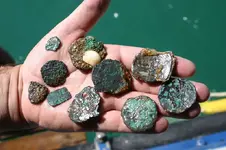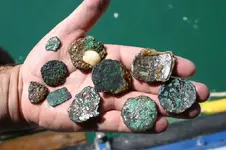Maybe this story from about 5 years ago will provide some motivation.....Stan
Hurricane Unburies Beach Treasure, Yields Precious Coins
The Orlando Sentinel, on Mon, Oct. 25, 2004
by RICH MCKAY
INDIALANTIC, Fla. - (KRT) - It is the stuff of pirate legends, but do not waste your breath asking Joel Ruth on what stretch of Florida's Treasure Coast he found his hoard of Spanish pieces of eight - waiting to be scratched out of the sand with bare fingers and toes.
Treasure hunters guard their secrets.
Especially, if like Ruth, they have just found about 180 near-mint silver coins worth more than $40,000.
To most Floridians, hurricane season is the time to board up windows and dread the worst. But to professional and amateur treasure seekers, it is the time to hit the beaches and hunt lost riches.
"It's why we're called the Treasure Coast," said Ruth, a bookish 52-year-old marine archaeologist with an African parrot named Euclid who has learned to squawk "Pieces o' eight."
It takes the big storms like Jeanne and Frances to rake several feet of sand off the beaches and dunes and expose gold, silver and gems sunk and scattered centuries ago.
But making a find takes more than walking the beaches with a metal detector. What separates those who make a real find from the legions of beachcombers is knowledge and patience, said Sir Robert F. Marx.
Marx is an underwater archaeologist and marine historian who was knighted by both the Spanish and English crowns for his work, including about 800 popular and scientific articles and about 60 books.
His colleague Ruth, for instance, has been keeping his eye on a certain stretch of beach in Brevard County, Fla., for 20 years, checking it every so often as the years go by, Marx said. He and Ruth think the find is part of a sunken treasure fleet off Florida's Atlantic coast.
But it took Jeanne to bring a slice of the shoreline back to where it was in 1715, he said.
That is the year a famous Spanish treasure fleet of about a dozen ships sunk in a summer hurricane, bloated with treasure headed for Philip V of Spain, Marx said.
Captain-General Don Juan Esteban de Ubilla, commander of the flotilla carrying gems, gold, silver and porcelain from China - hence the name Plate Fleet - set sail in the late summer 289 years ago.
Under pressure from the king to bring treasure to boost a war-ravaged economy, Ubilla set sail even though hurricane season had already started. Leading with the Capitana, the fleet hugged Florida's Atlantic coast, heading north in the hopes of catching the trade winds of the Gulf Stream. With no more warning than a morning of steel-gray skies, a tempest snapped the ships like matchsticks, a few survivors would later tell.
Nautical records of salvage attempts and previous finds pointed to the spot Ruth staked out to search. Others know the spot and have made finds there, too.
The basic rules of treasure hunting on beaches include finders keepers, but do not dig into the dunes or in protected areas.
Because riches go to those who are there first, "You have to be Johnny on the spot," said Mitch King, vice president of the Treasure Coast Archaeological Society.
"(Hurricane) Jeanne did more destruction than any storm has in years," King said. The last storm to yield finds like Ruth's happened on Thanksgiving about two decades ago, he added. Treasure hunters still whisper about it.
And you have to be quick, Ruth said, because the high tides right after a storm often dump several feet of sand back on the same beaches, leaving the heavy treasure well below the reach of most metal detectors.
"You could be walking over a million dollars in coins and never know it," said Ruth, who makes a living on salvage efforts and identifying and restoring ancient coins.
He headed out with his metal detector about 8 a.m. Sept. 26, when Jeanne's winds started slacking off. He knew the storm that brought some of the worst destruction to Florida's coast could also yield the most riches.
He would not say where he went other than "somewhere in Brevard." He shimmied down to the beach from a place where there is access - and knew right away it was a good spot. There was no modern trash - and the waves had cut deep into the sand.
"I made a find almost immediately - a big green (piece of) eight," he said.
It was green from age but was not worn or corroded, which told him the coin spent most of the time deep under the protection of the sand - making it far more valuable to collectors.
Ruth stayed for about four hours, filling his pockets with coins until his batteries were about dead and the high tides' waves bashed him against the sandy cliffs.
He went back the next day, but there was too much sand piled up. He did not find a thing, other than modern rubbish.
He showed his find to Marx, who smiled with approval and the respect of a fellow hunter. Although many marine archaeologists would call them "plunderers," professional treasure hunters say they give more discoveries to museums and make more historical finds because their ventures pay for new searches a life in academics could not finance.
And where does Ruth find the coins? "I'm sworn to secrecy," Marx said.
But if another storm hits before hurricane season ends Nov. 30, he will probably go back.






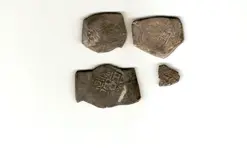
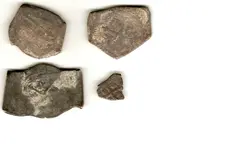
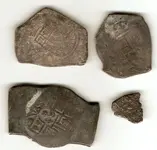
 The answer is no. ...not lately...not likely. After a storm, yes, its certainly possible.
The answer is no. ...not lately...not likely. After a storm, yes, its certainly possible.